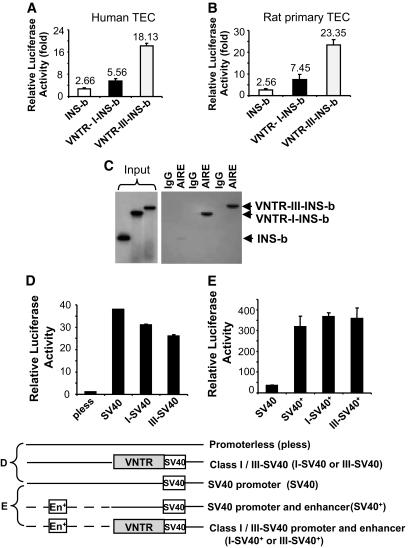FIG. 5.
AIRE regulates the insulin promoter activity mediated through the INS-VNTR element. A and B: Insulin basal promoter, VNTR-class I-INS-basal and VNTR-class III-INS-basal vectors demonstrated differential promoter activities in both hTEC and rat primary TEC in response to AIRE. C: DNA probes derived from insulin basal promoter (0.4 kb), VNTR-class I-INS-basal (2.0 kb), and VNTR-class III-INS-basal (3.5 kb) were radiolabeled with T4 polynucleotide kinase and γ-32P-ATP as shown in the input lanes. An Ad-AIRE transduced hTEC total lysate (100 μg) was mixed with 50,000 cpm of each radiolabeled DNA probe for 6 h at room temperature and subsequently added 1 μg of goat anti-AIRE antibody for an overnight incubation. The immune complex was precipitated by salmon sperm DNA-treated protein G-agarose beads, washed, and eluted from beads for separation. Normal goat IgG was used as a negative control. The immunoprecipitated AIRE complexes were verified using an anti-AIRE antibody. D: VNTR linked to a heterologous promoter failed to respond to AIRE. The insulin basal promoter was replaced by a SV40 promoter in a reporter construct. Transfection of the construct lacking the insulin basal promoter with the AIRE expression vector in human TEC was measured for luciferase reporter activity. E: Addition of a SV40 enhancer to the construct greatly enhanced SV40 promoter activity, but the class I or III VNTR had no effect on the promoter/enhancer combination. Transfection efficiency was normalized with the null-Renilla luciferase reporter vector.

